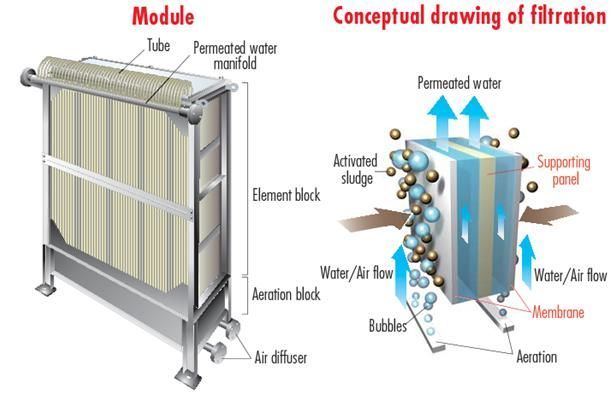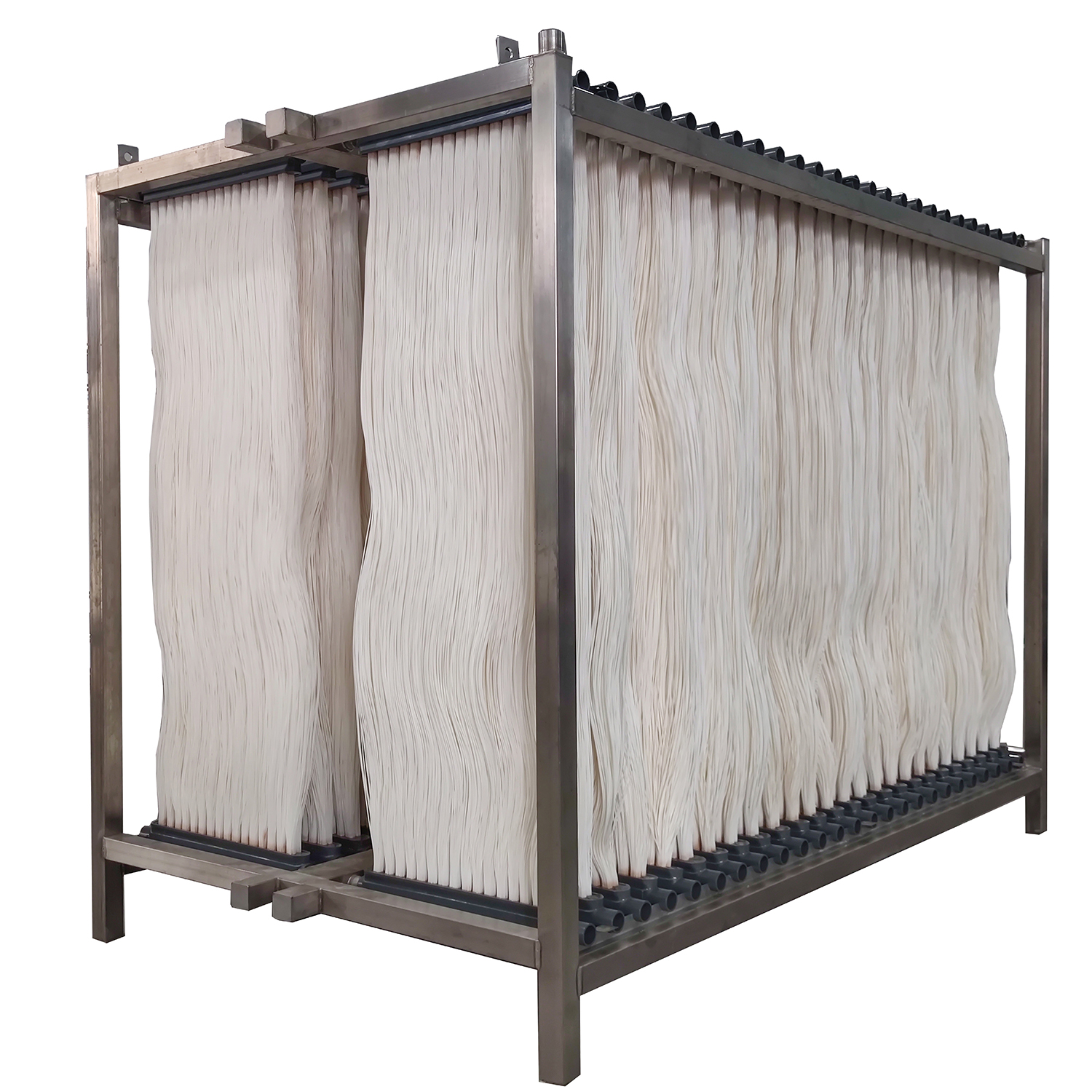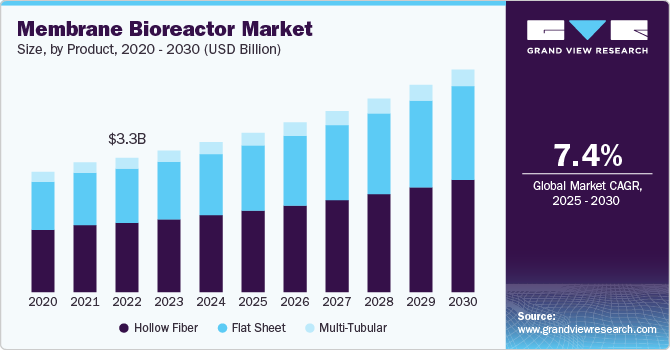Membrane Bioreactor as a Sustainable Solution for High-Volume Wastewater Treatment
Membrane Bioreactor as a Sustainable Solution for High-Volume Wastewater Treatment
Blog Article
Exactly How Membrane Bioreactors Are Reinventing Water Purification Equipments
The introduction of membrane layer bioreactors (MBRs) stands for a substantial development in the field of water purification, merging biological therapy procedures with advanced membrane filtering modern technologies. As international water deficiency escalates, the role of MBRs in facilitating potable water reuse and sustainable water monitoring comes to be significantly essential.
Review of Membrane Layer Bioreactors
Membrane layer bioreactors (MBRs) represent a significant advancement in water filtration modern technology, as they integrate biological treatment procedures with membrane layer filtration. This integration boosts the effectiveness of wastewater treatment by utilizing microbes to break down organic pollutants while simultaneously using semi-permeable membranes to separate cured water from suspended solids and pathogens.
The MBR system normally includes an organic activator where the microbial population metabolizes impurities, complied with by a membrane layer filtering unit that preserves biomass and allows only tidy water to pass through. This twin performance causes higher effluent top quality compared to standard treatment approaches. MBRs can be operated in both set and constant circulation modes, supplying versatility in layout and application.
They also enable the recovery of water for reuse, therefore contributing to water sustainability efforts. In general, MBRs are at the center of improving water treatment effectiveness and high quality, showcasing the possibility for cutting-edge solutions in environmental management.
Advantages of MBR Innovation
The combination of organic therapy with membrane layer purification supplies numerous benefits for water filtration procedures. Among the key advantages of Membrane layer Bioreactor (MBR) technology is its capability to successfully eliminate both inorganic and organic pollutants, resulting in top notch effluent. The membrane layers function as a physical obstacle, stopping put on hold solids and microorganisms from going through, which enhances the overall safety and reliability of cured water.
In addition, MBR systems need a smaller footprint contrasted to standard therapy techniques, allowing for more efficient room use. This small design is specifically useful in metropolitan settings where land is restricted. MBRs likewise demonstrate operational adaptability, fitting varying influent top qualities and circulation rates without substantial efficiency deterioration.
Furthermore, the procedure uses improved nutrient removal capacities, especially for nitrogen and phosphorus, which are crucial for preventing eutrophication in receiving waters. The lowered sludge manufacturing related to MBR technology additionally translates to decrease disposal expenses, making it an economical solution in the lengthy run - Membrane Bioreactor. In general, the advantages of MBR innovation position it as a leading option for innovative and lasting water purification systems, attending to both ecological and financial problems
Applications in Water Purification
Applications of Membrane Bioreactor (MBR) technology in water filtration are impactful and diverse, resolving various treatment requires across multiple markets. MBRs effectively integrate organic treatment processes with membrane layer filtration, making them suitable for municipal wastewater treatment, commercial effluent monitoring, and even drinkable water reuse campaigns.
In community settings, MBRs are progressively used to boost the top quality of dealt with wastewater, permitting compliance with strict discharge policies and assisting in the recycling of water for watering and non-potable usages. Their small style likewise makes them appropriate for metropolitan settings where area is restricted.
Industrially, MBR innovation is used to deal with process water and wastewater, especially in markets such as food and beverage, pharmaceuticals, and textiles. By successfully eliminating pollutants and suspended solids, MBRs assist industries reduce environmental impacts while recovering valuable sources from wastewater streams.
In Addition, MBRs are getting grip in decentralized water treatment applications, where small-scale systems can be released in remote locations or creating regions. This versatility enables areas to attain lasting water administration solutions, boosting accessibility to clean water while decreasing reliance on typical therapy techniques.
Case Researches and Success Stories

In one more instance, a textile production facility in Bangladesh took on MBR innovation to address its wastewater obstacles. The system decreased chemical oxygen need (COD) levels from 1,200 mg/L to much less than 100 mg/L, thus fulfilling regulatory criteria and considerably decreasing environmental influence.
The University of Cape Community's MBR installation has actually proven efficient in dealing with greywater for non-potable reuse over here on campus. This task not only saves safe and clean water however additionally acts as an academic version for sustainable methods.
Furthermore, a seafood handling plant in Norway made use of MBR innovation to deal with effluents containing high levels of raw material, achieving over 90% contaminant elimination. These study highlight MBR modern technology's flexibility and its crucial duty in enhancing water high quality throughout varied applications.
Future of Water Therapy Solutions
As global water scarcity and contamination obstacles intensify, ingenious water treatment options are coming to be increasingly vital to make sure lasting accessibility to tidy water. The future of water therapy hinges on the assimilation of advanced technologies that enhance the efficiency and efficiency of filtration procedures. Membrane layer bioreactors (MBRs) are at the leading edge of this development, incorporating organic therapy with membrane layer filtering to create high-grade effluent ideal for numerous applications.

Arising trends such as source healing from wastewater, consisting of nutrients and energy, will certainly further transform therapy centers into environmentally friendly hubs. Additionally, advancements in nanotechnology and membrane layer products guarantee improved efficiency and long life of filtering systems.

Final Thought
To content conclude, membrane layer bioreactors represent a significant advancement in water filtration innovations, effectively integrating biological therapy with advanced membrane layer filtration. The countless advantages, consisting of improved effluent top quality and decreased spatial needs, make MBRs particularly ideal for urban applications. Their duty in potable water reuse and lasting water management highlights their value in addressing worldwide water deficiency challenges. Proceeded research and advancement will certainly further improve the efficiency and adoption of MBR innovation, making certain a resilient future for water therapy remedies.
The development of membrane layer bioreactors (MBRs) stands for a substantial innovation in the area of water purification, merging biological treatment processes with advanced membrane filtering innovations. As worldwide water shortage escalates, the role of MBRs in facilitating drinkable water reuse and sustainable water administration ends up being progressively vital. They likewise make it possible for the recuperation of water for reuse, thus contributing to water sustainability campaigns.As worldwide water deficiency and air pollution difficulties increase, cutting-edge water therapy options are ending up being increasingly important to guarantee sustainable accessibility to tidy water. Their function in potable water reuse and sustainable water monitoring highlights their value in attending to worldwide water scarcity challenges.
Report this page